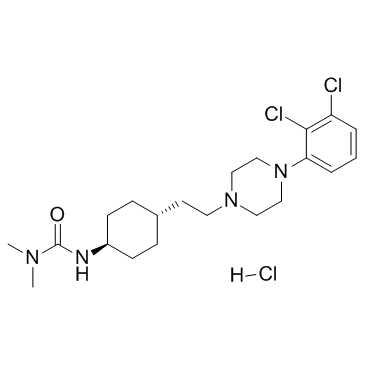Cariprazine hydrochloride (Synonyms: RGH-188) |
| Catalog No.GC35610 |
An atypical antipsychotic
Products are for research use only. Not for human use. We do not sell to patients.

Cas No.: 1083076-69-0
Sample solution is provided at 25 µL, 10mM.
Cariprazine hydrochloride is a novel antipsychotic drug candidate that exhibits high affinity for the D3 (Ki=0.085 nM) and D2 (Ki=0.49 nM) receptors, and moderate affinity for the 5-HT1A receptor (Ki=2.6 nM). Ki: 0.49 nM (D2 receptor), 0.085 nM (D3 receptor), 2.6 nM (5-HT1A receptor)[1]
Cariprazine stimulates inositol phosphate (IP) formation with a high potency (pEC50 8.5) with relatively low efficacy (Emax 30%)[2]. Cariprazine, a novel candidate antipsychotic, demonstrated approximately 10-fold higher affinity for human D3 versus human D2L and human D2S receptors (pKi 10.07, 9.16, and 9.31, respectively). Cariprazine displays high affinity at human serotonin (5-HT) type 2B receptors (pKi 9.24) with pure antagonism. Cariprazine has lower affinity at human and rat hippocampal 5-HT1A receptors (pKi 8.59 and 8.34, respectively) and demonstrates low intrinsic efficacy. Cariprazine displays low affinity at human 5-HT2A receptors (pKi 7.73). Moderate or low affinity for histamine H1 and 5-HT2C receptors (pKi 7.63 and 6.87, respectively) suggest Cariprazine's reduced propensity for adverse events related to these receptors[2]. Cariprazine is over sixfold more potent (EC50=1.4 nM) than Aripiprazole (EC50=9.2 nM) in inhibiting isoproterenol-induced cAMP production in HEK-293 cells[4].
Administration of Cariprazine (30 µg/kg) reduces the striatal uptake of both radioligands to the level of nonspecific binding compared with baseline PET measurements. Cariprazine has negligible effect on the time-activity curves in the cerebellum. At doses of 5.0 and 30 µg/kg, Cariprazine causes a dose-dependent dopamine D2/D3 receptor occupancy of ~45% and ~80% for both antagonist [11C] raclopride and agonist radioligand [11C]MNPA. Receptor occupancy of dopamine D2/D3 receptors calculated using the transient equilibrium and the MRTM2 methods ranged from 5% at the lowest dose (1.0 µg/kg) to 94% at the highest dose (300 µg/kg)[1]. The effects of 5 doses of Cariprazine (ranging from 0.005 to 0.15 mg/kg) are examined on EPM behavior of wild-type mice. Whereas lower doses of Cariprazine (0.005 to 0.02 mg/kg) do not alter the time spent in open arms, the two higher doses (0.08 and 0.15 mg/kg) lead to a significant decline of this measure (ANOVA, (F(5,52)=4.20; p=0.0032)). Moreover, the two higher doses of Cariprazine also lead to a significant decrease in the total number of arm entries (F(5,52)=7.21; p=0.0001)) but this decrease in the total number of arm entries is largely accounted for by a significant decrease in the number of closed arm entries (F(5,52)=11.75; p=0.0001)). The two highest doses of Cariprazine (0.08 and 0.15 mg/kg) have significant effects on locomotor activity, but doses ranging from 0.005 to 0.02 mg/kg do not affect anxiety-like behavior or locomotor activity in the EPM test[3]. A significant (P<0.01) reduction in ouabain-induced hyperactivity is observed after acute i.p. administration of all doses of Cariprazine (mean±SEM: 0.06 mg/kg, 64.2±3.88; 0.25 mg/kg, 72.7±11.67; 0.5 mg/kg, 40.6±5.32; 1 mg/kg, 19.5±8.78) and lithium (40.4±12.78), compared with ouabain injection alone (114.6±14.33). The highest Cariprazine dose produced significant sedation (72% inhibition for Cariprazine 1.0 mg/kg aCSF vs. saline aCSF; P<0.05)[4].
[1]. Seneca N, et al. Occupancy of dopamine D2 and D3 and serotonin 5-HT1A receptors by the novel antipsychotic drug candidate, cariprazine (RGH-188), in monkey brain measured using positron emission tomography. Psychopharmacology (Berl). 2011 Dec;218(3):579-8 [2]. Kiss B, et al. Cariprazine (RGH-188), a dopamine D(3) receptor-preferring, D(3)/D(2) dopamine receptor antagonist-partial agonist antipsychotic candidate: in vitro and neurochemical profile. J Pharmacol Exp Ther. 2010 Apr;333(1):328-40. [3]. Zimnisky R, et al. Cariprazine, a dopamine D(3)-receptor-preferring partial agonist, blocks phencyclidine-induced impairments of working memory, attention set-shifting, and recognition memory in the mouse. Psychopharmacology (Berl). 2013 Mar;226(1):91-100. [4]. Gao Y, et al. Cariprazine exerts antimanic properties and interferes with dopamine D2 receptor β-arrestin interactions. Pharmacol Res Perspect. 2015 Feb;3(1):e00073. [5]. Citrome L. Cariprazine in schizophrenia: clinical efficacy, tolerability, and place in therapy. Adv Ther. 2013 Feb;30(2):114-26.
Average Rating: 5 (Based on Reviews and 20 reference(s) in Google Scholar.)
GLPBIO products are for RESEARCH USE ONLY. Please make sure your review or question is research based.
Required fields are marked with *




















